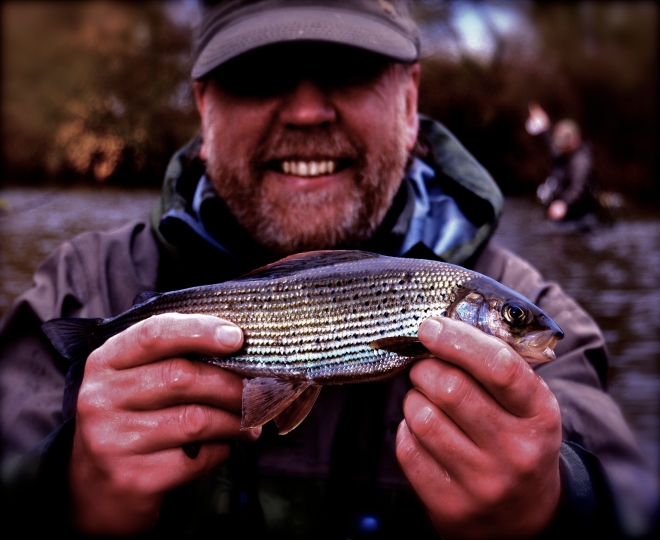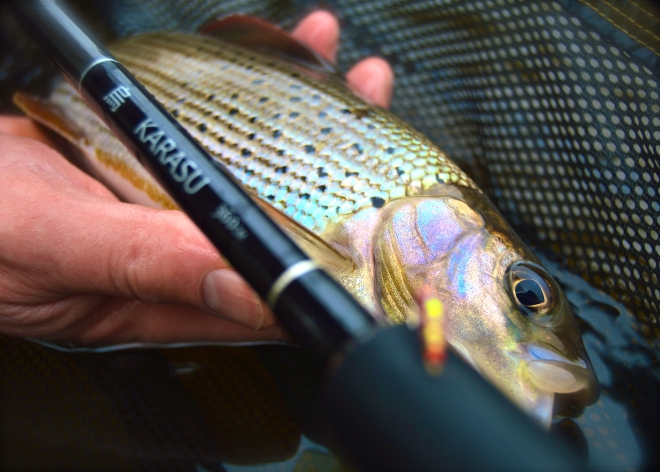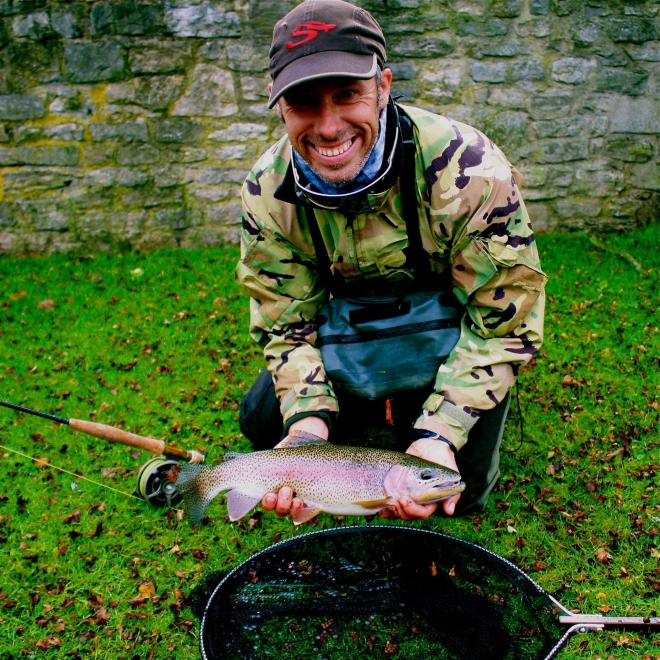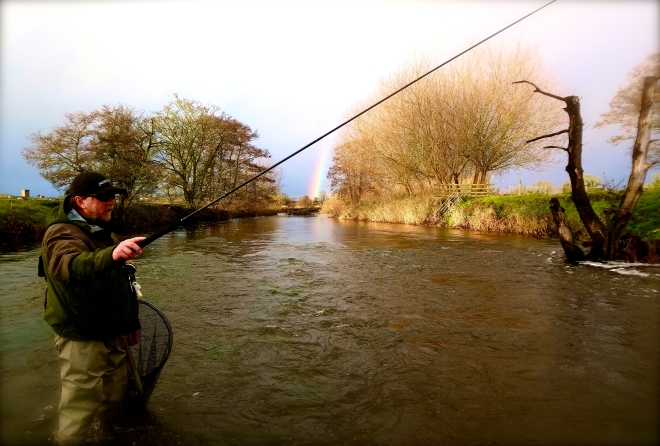
Hard times and humour go together hand in glove. It’s part of the English condition I think, laughing in the face of adversity. Sometimes it’s the only thing holding you up. Good job today then that I’m in jovial company. Hard times and humour. The one is the seasoning of the other.
Speaking of seasoning, we are sitting in driving wind and icy rain enjoying a spicy chicken risotto cooked up from the field kitchen by pro guide Andy Buckley. He’s pulled off what feels a bit like silver service in the middle of the Battle for the Somme, and I have to say I’m impressed. The tangy warmth is firing up my central heating again, a welcome respite from wading the cold-so-cold water of the River Dove. I wish I had longer to savour the meal but my plate is filling up with rain water. Such is the pursuit of winter grayling.
The fishing this trip is as hard as nails. Back-wind to yesterday: we are fishing unguided, exploring the Izaak Walton beat of the upper Dove. Here the river tumbles through a limestone gorge carved out by glaciers millennia ago. My buddy Paul Williams forensically fishes the water with short line euro nymph tactics, I’m experimenting with a fixed line version, searching the water with a team of weighted hackle and shrimp patterns. So between us we have some bases covered, having set off earlier with great expectations. Just as well then that we hadn’t read the entry for yesterday in the hotel catch return – “there were eighteen of us and we caught owt!”

Spectacular scenery though and if you have to blank this is the place to do it. The revery is broken by Paul’s announcement that the felt sole of his wading boot is now mostly adrift. We slip and slide back up the muddy field to the van, Paul’s boot by now flapping like Coco the Clown’s. It’s nothing a trip to B&Q, some Gorilla Glue and a hair dryer can’t fix. Only thing now is the boot has a platform heel. So here it is merry Christmas. It feels like it’s made of concrete, Paul tells me. Pretty much a testament to his dedication and toughness that he fishes on for the rest of the expedition with nere a moan. Me, I’d be whinging still.
So day two, and all is resting on Andy putting us on fish. We are now on the middle reaches of the Dove, a stretch Andy knows intimately. I have every confidence we will have fish in front us – the challenge today is the weather. This morning there is snow on the hills and on the roof of the van, and thick ice on the windscreen. This sudden plunging temperature and rising pressure doesn’t bode well for our chances I think, but I’m carried along by Andy’s optimism.

But the weather Gods laugh in our faces as weather front after weather front crashes in. One moment wind and rain. Then blue sky and a vivid rainbow. Next sleet, then hail then calm again, followed by more icy rain. But we are here to fish and fish we shall and fish we shall have. Paul is first in with a juvenile grayling, small, but it’s a fish and we’ve broken our collective duck and there’s sure to be others.
I’m interested to learn from Paul and Andy’s French leader tactics which can be deadly for tricky grayling. I’m looking to emulate their presentation with my fixed line rod. Andy has never guided tenkara and I’m pretty new to nymphing with a tenkara rod so this cross-over is interesting from both sides. Andy rigs me up with a set up he thinks will work well for this mark – a pink tungsten beaded point fly, with my pink weighted shrimp on a 5 inch dropper, about eight inches above the point fly. The overall tippet length matches the depth of the water I am fishing. Andy has tied a dropper ring to the end of the tippet first, which allows the dropper and point fly distances to be adjusted by swapping in a new length of fluoro to either fly. Casting line is 12ft of green level nylon – normally too light for these windy conditions, but the weighted flies make this a null point.
French leader tactics are all about tuning your beads to the flow, with the aim of using just sufficient weight in the fly to tick and bounce the point fly along the river bed. Holding my rod tip high and with the weight just right, the ticking can be felt through the metal end cap of my rod handle, held in the palm of my hand.

Copying the lads I flick my team up stream. At first, casting feels strange and unwieldy, but I discover a side cast technique that has some delicacy even with these clunky patterns. With a bit of practice I’m getting reasonable accuracy too. It’s trickier to describe than it is to do, but in simple terms the cast goes like this: I’m allowing the nymph rig to pass down stream and at the end of my drift a lift of the rod brings the flies to the surface. Using the water tension to load the rod, a low side cast flicks the flies up stream, and as the flies are passing in front of me I’m lifting my rod tip high. This means the flies travel under and in front of the rod tip. As they complete the upstream part of the cast they begin to swing as a pendulum. By lowering the rod tip, the flies can be placed down fairly softly and with no casting line touching the water.
All four parts of the cast are done in one fluid motion – lift – side cast – raise rod- lower rod. It also has the benefit of keeping those heavy flies away from that expensive rod blank! Pretty good too when you have brush at your back. Once the flies are fishing up and across, I’m tracking the rig back, with the casting line leading downstream, trying to keep just enough tension to spot when the casting line slows or pauses. This could be a snag or it could be a take, so any change in the status of the tip of the casting line is met with a lift of the rod.

It’s my turn next for a fish. The tip of the casting line, which is just brushing the surface, pauses and I lift and feel a soft weight. At first I think I’ve snagged another autumn leaf, but the cold numbed fish soon wakes up and kicks. A lovely little grayling to hand – not huge but now it’s game on and soon a better fish follows.
Paul’s into fish again, and is picking up a higher number of smaller fish. My hook ups are fewer but I’m lucky enough to pick up a bigger grayling. Looking back afterwards my conclusion is that our presentations and take detection are comparable in efficacy but Paul’s hook set with his western gear is more effective. I think the answer for me is to strike with more energy to convert those takes. Plenty of lifts were met with that soft weight that I took at the time to be a leaf or weedy snag, but in retrospect could well have been fish. Just such a take turned out in fact to be a fine out of season wild brownie which I took to be another stick – until it woke up in the icy water and gave me a good old run around. Lessons learned for next time and I’m looking forward to studying Paul’s nymph tactics further to learn how I might cross these over into a fixed line approach.




























